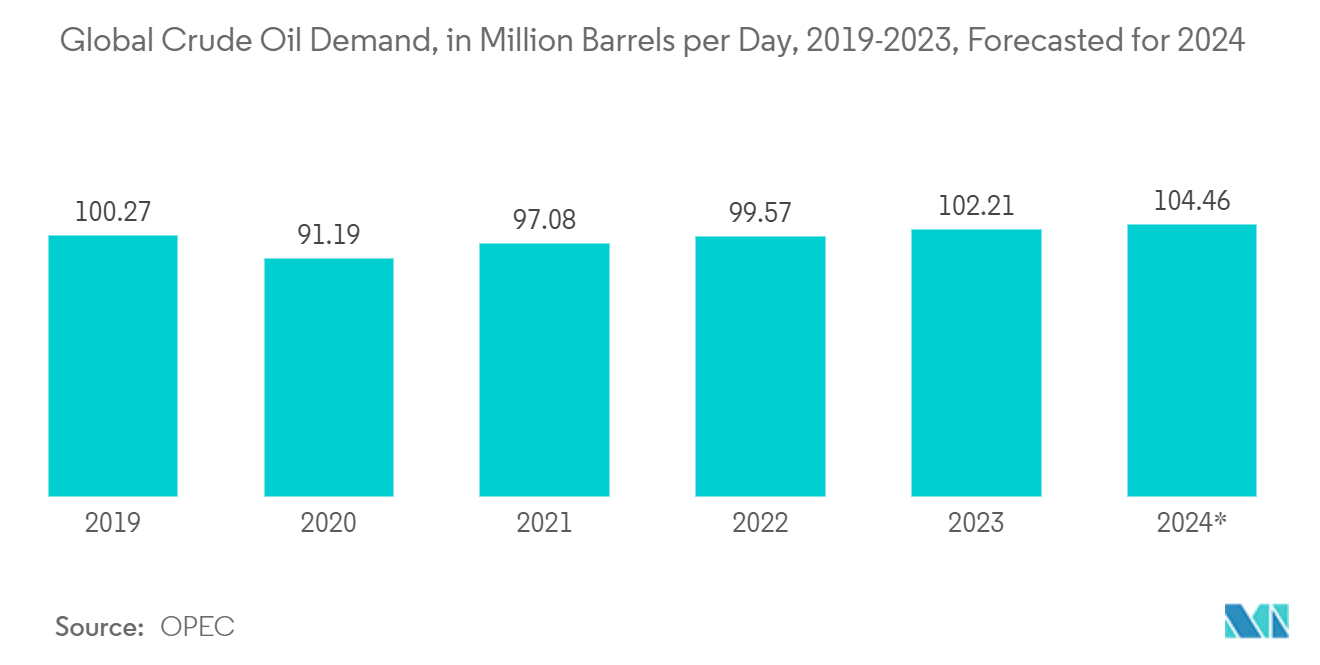Market Trends of Mooring Line Connector Industry
Oil and Gas Industry Expected to Share Wide Traction
- As energy transitions progress, the world's demand for oil is projected to decelerate in the coming years. Concurrently, global oil production is poised to increase, alleviating market pressures and elevating spare capacity to levels not seen post-pandemic, as highlighted in the IEA's latest oil market outlook.
- The IEA's "Oil 2024," its annual medium-term market report, delves into the extensive ramifications of these shifts on oil supply security, refining, trade, and investment. The report indicates that driven by robust demand from rapidly growing Asian economies, along with the aviation and petrochemical sectors, oil consumption is set to rise in the coming years, based on current policies and market trends.
- According to OPEC, global crude oil demand (inclusive of biofuels) reached 102.21 million barrels per day in 2023. OPEC anticipates a rebound in economic activity and corresponding oil demand by year's end, projecting an uptick to over 104 million barrels per day.
- Consequently, there's been a notable surge in investments towards offshore oil exploration. For example, in January 2024, India inked contracts for ten oil and gas exploration blocks under the recent OALP-VIII bid round. Government-owned ONGC emerged as the frontrunner, clinching seven out of the ten blocks, as reported by PTI via the Economic Times. Official announcements reveal that the exploration work program across the awarded 34,364 km² blocks is projected to draw investments of approximately USD 233 million (Rs 19.4 billion).
- Given the burgeoning oil and gas sector, the demand for mooring line connectors is anticipated to rise significantly. These connectors are vital for maintaining platform stability, even in turbulent sea conditions, ensuring the safety of the entire platform and its crew.

North America is expected to observe significant growth rates
- Increased energy demand has driven up oil and gas production across North America. According to March 2024 data from the U.S. Energy Information Administration (EIA), U.S. crude oil production, including condensate, averaged 12.9 million barrels per day (b/d) in 2023. This figure surpassed the previous U.S. and global record of 12.3 million b/d, set in 2019. The U.S. led global crude oil production with a rate of 12.4 million b/d, outpacing other major oil-producing nations.
- December 2023 marked a milestone, as U.S. crude oil production hit a record surge of over 13.3 million b/d. Furthermore, U.S. natural gas production saw a 4% increase in 2023, averaging 125.0 billion cubic feet per day (Bcf/d), translating to an uptick of 5.0 Bcf/d, as reported in our Natural Gas Monthly.
- Moreover, the exploration of offshore oil and gas resources has expanded into deep and ultra-deepwater regions in recent years. The count of offshore floating oil and gas production systems has risen. Industry executives assert that offshore production is not only vital for fueling vehicles and power plants but also more environmentally friendly than onshore drilling. This is primarily because offshore operations emit significantly fewer greenhouse gases than their onshore counterparts, as per industry estimates.
- Given this context, the growing significance of mooring line connectors becomes evident, especially since the offshore industry is at the forefront of advancing open sea mooring technology.
- As marine transportation gains traction, the market is poised for further expansion. Data from June 2024, sourced from the National Oceanic and Atmospheric Administration, highlighted a 7% surge in marine transportation and warehousing in 2022, culminating in sales of USD 56 billion. With such substantial investments at stake, the significance of reliable mooring line connectors is underscored, especially since studies indicate that the chain, connector, and wire rope are the top three components linked to most incidents.


